The principle of saving fuel
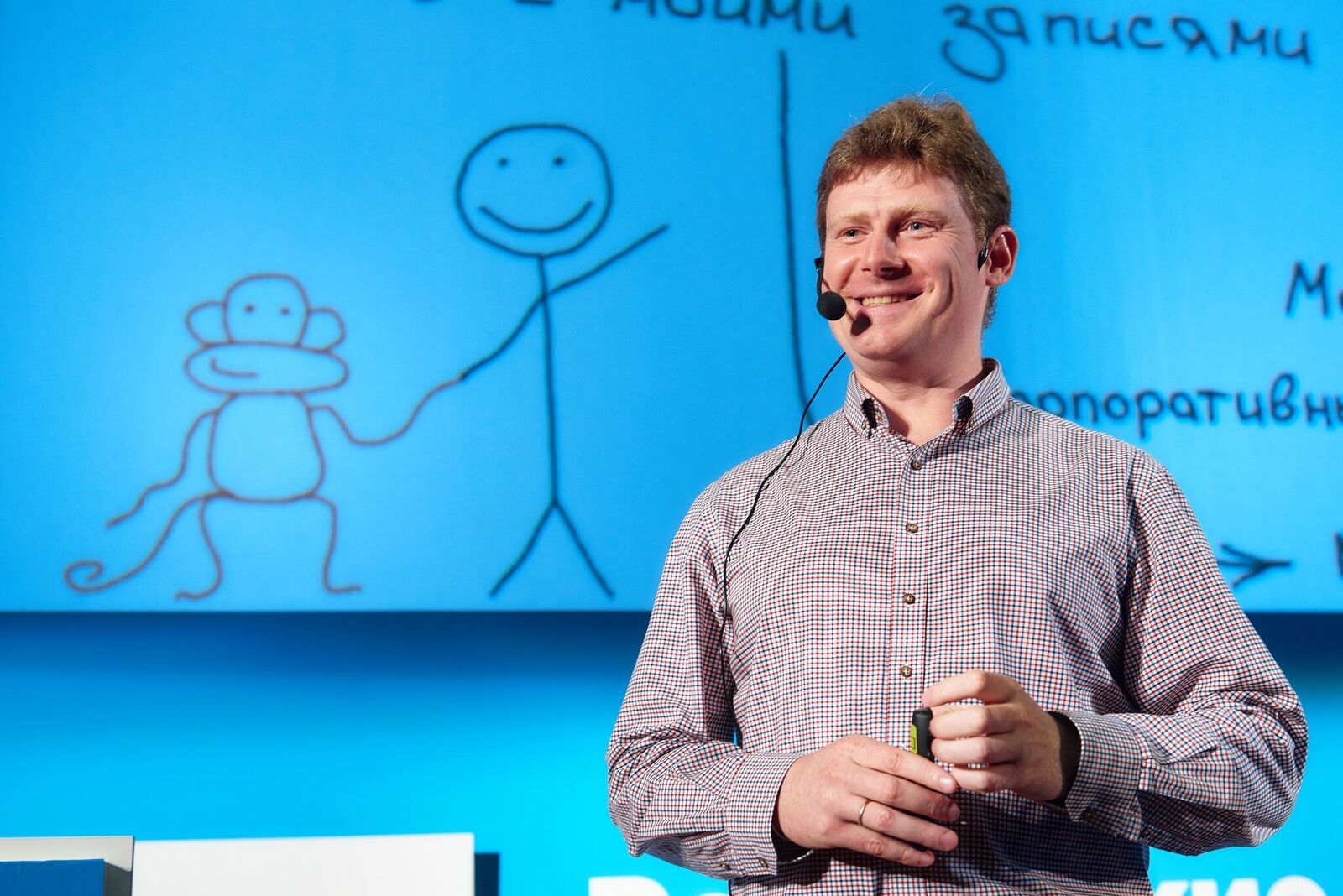
Submissions, in our opinion, are unnecessary. Under the report is the report of the guru of procrastinology, Maxim Dorofeev , in which he will tell you how to do more and less tired . We learn a little about the monkey, efficiency and much more. It is even possible that after reading half of everything that you heard earlier about thinking will depreciate.
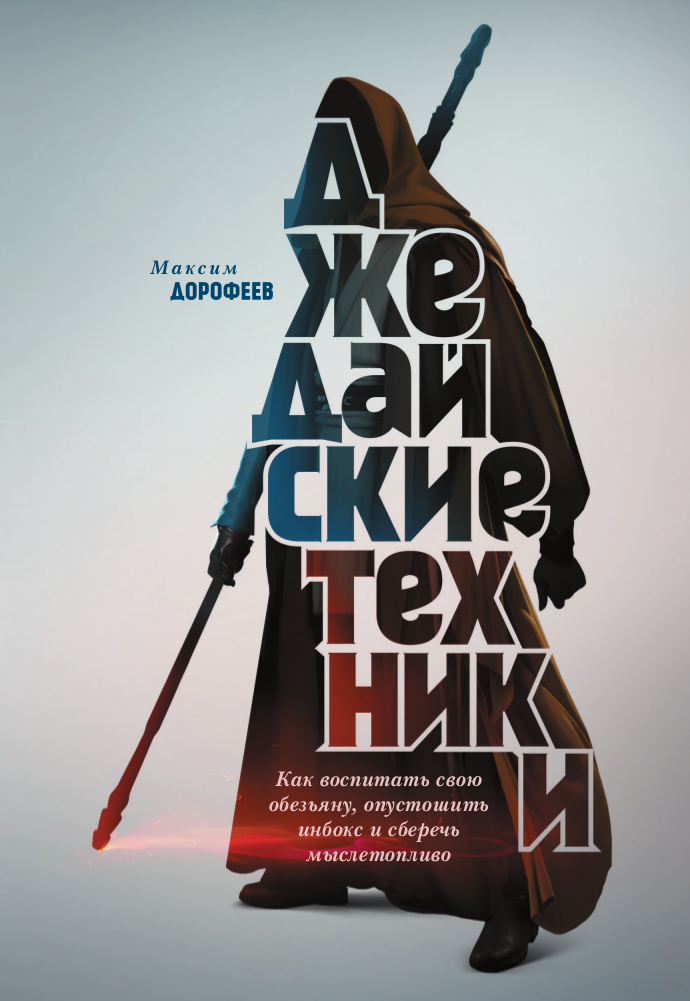 About speaker
About speaker Maxim Dorofeev ( mnogosdelal.ru ) seems to be an IT specialist. More precisely, it is no longer an IT specialist, but initially he wrote code with his own hands and all that. At the age of 13, he earned his first money by programming, and then, up to more than 30, was in the IT industry until he quit and became a procrastinologist and began to engage in any kind of psychology. So carried away that wrote a whole book : you will probably come in handy. Moreover, it so successfully coincided that now the publisher has discounts - on smaller paper books, on electronic and audiobooks - more.
Maxim Dorofeev, it’s not for nothing that the trainings are conducted - a great storyteller! The article, unfortunately, can not convey all the energy and enthusiasm, but you love to read! And it will be more convenient to return to it, in another attempt to resolve very important and super important tasks. Happy reading or watching, because the video is also available.
')
How it all began ...
How did I even come to procrastinology? I am an introvert child, raised by IT specialists, who has been in the field of software development for quite a long time.
Many of the books that I read as a child grown by IT specialists were specific. One of them - Frederick Brooks's “Mythical Man-Month” left an indelible mark on me. This is a smart book whose ideas help IT professionals to justify their own continuation. From here came such phrases:
"9 women in a month will not give birth to a child"
“What a programmer does in a month, two programmers do in 2 months.”
In addition, in the book of Brooks introduced the concept of a 10-fold programmer. The author referred to the studies of the mid-60s, in which it is shown that the performance (or productivity) of a mediocre programmer differs from the productivity of an awesomely good programmer not by 10–20%, as usually salaries differ, but dozens of times. Later, in the mid-80s, de Marco referred to studies with approximately the same conclusions - you can work 20 times better, and a productive programmer differs from a mediocre not by 10-20%.
At the same time, programmers, as you understand, are not much different from a number of other intellectual workers, and about the same nature of the work occurs in the head, for example, among designers, marketers, copywriters, managers. This is a certain layer of professions, where most of the work takes place in the head. For them, with a very good probability, this rule of 10-fold difference in productivity in a given state is also true.
Since then, I began to wonder: what can a mediocre person make a good person, whose productivity is 10-20 times higher?
It's not even that programmers are different. The same person over time can vary their productivity by 10 times. I think everyone is familiar with the state when you come joyful, cheerful, do something in 15 minutes and be pleased. But about the same task in a week you sit and you can not do half a day. Here it is - a 10-fold difference in performance.
Since then, I have invented a slogan. He is not mine, it is a phrase in Latin, which Hannibal spoke to Hiskonu in the battles of Cannes. Hannibal, if anyone remembers, is the character who, with a very small army, very successfully, productively, in our terms, terrorized the entire Roman Empire with its huge army. In the battle of Cannes, he admonished his fighter Hiskon, who complained that the enemy had a large numerical superiority:
- Do not worry, there are many of them, but they do not have a giskon! Unos sed leo!
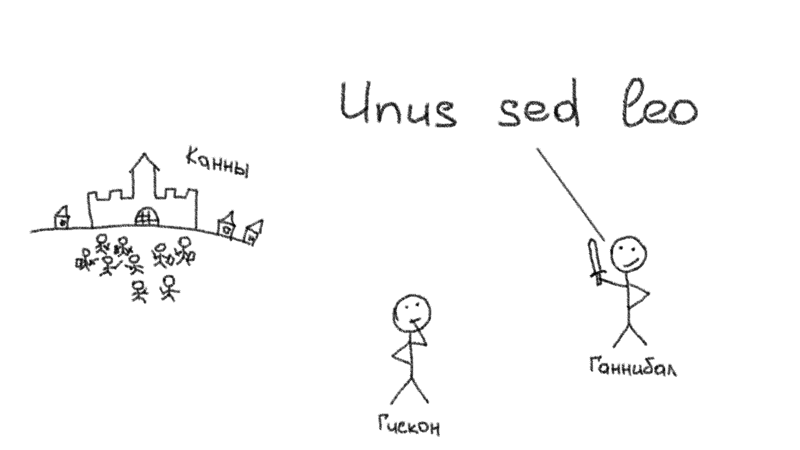
What does “One, but the lion” mean, or, in Russian, “We are few, but we are in vests!”
A little later, based on this image of a warrior, I was born the name of my book. I suspected that what makes a person productive (or not productive) is like the mid-chlorins in the blood of the Jedi. Since then, these words are stuck - "Jedi technology," the book is called.
The probabilistic nature of the world
Now I will briefly tell you not what is in the book, but what is not in it, except for one small moment - how everything is arranged.
First, one little truth about our world:
In our world, not everything, everywhere and always, but something, sometimes in some places.
This is a subtle hint that our world is arranged, as scientists say, non-deterministic. No rules and no methodologies guarantee results. All that they do is affect the likelihood of a particular outcome. This is confirmed by the quotation from the smart diamond book Diamond Cutter by Geshe Michael Roach:
The same actions taken by the same people or companies seem to lead to different, almost random results.
As a result, 2-3 people can do the same thing and get different results. We are ready for this - such a world.
One says:
- I do this!
- Oh, we'll do it too! - answer the rest.
They do it, and 90% of them fail, because he was just lucky, not because he did just that. It also happens.
Universal Council
In such a non-deterministic world, one of the few potentially universal tips is:
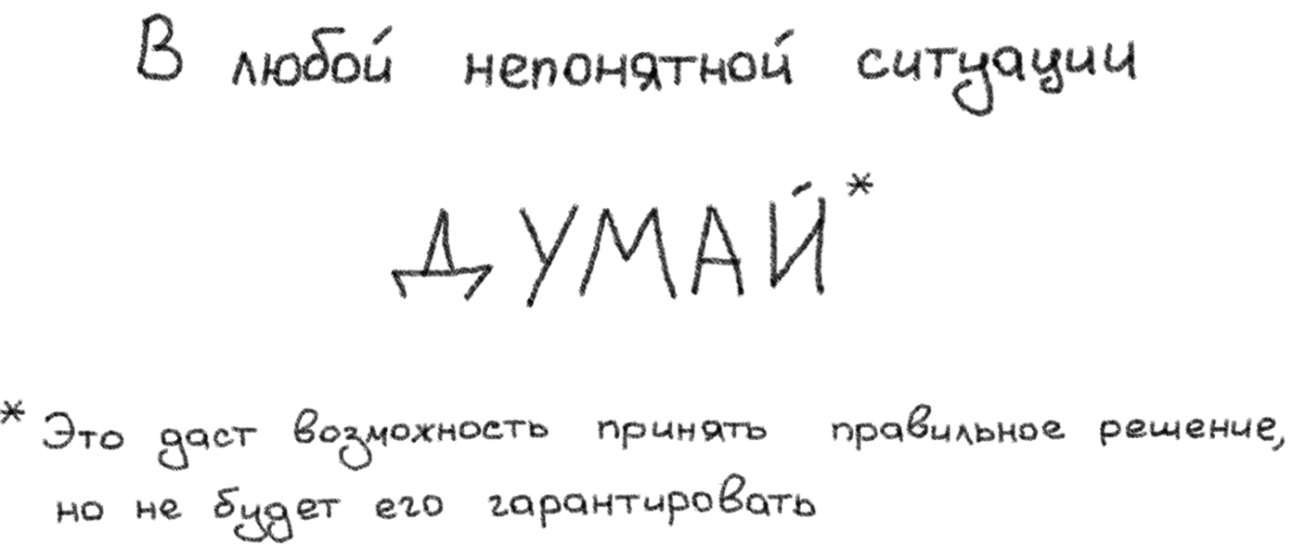
The summary of the book is all ahead of you: in any incomprehensible situation, you have to think.
But there is trouble.
What makes it hard for us to think
It is very hard for us to think for several reasons:
- The effect of cognitive obesity when we eat too much food for thought;
- We are too lazy to think - for most people this is a very unpleasant process;
- What we think is too small, much less than we think.
This determined the content of my story. But so that you do not have a feeling of incompleteness, I will give a hint at how to live with it.
About food for thought
Why can not we think in any strange situation?
I'll start from afar, with quotes 2 interesting experiments.
1. The Bruner-Potter experiment (1964)
The experiment consisted of the following, test living people (psychologists always carry out experiments like this) showed pictures of real household objects of varying degrees of distortion. The person looks at the picture and at some point finds out what kind of object it is, and the experimenters mark the level of distortion.
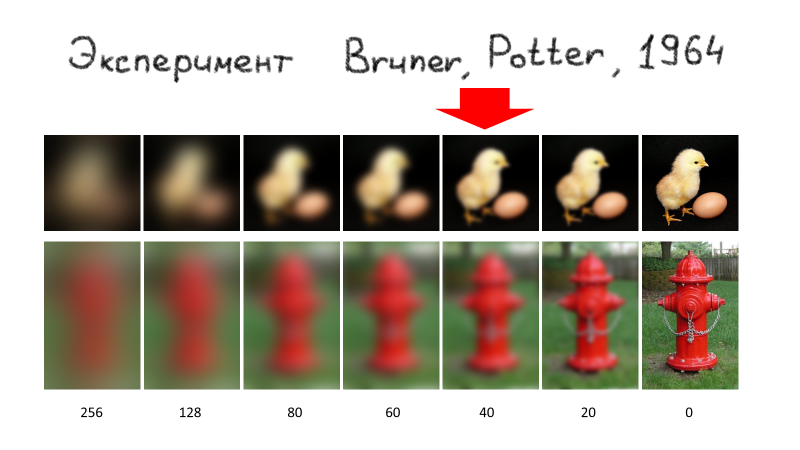
Moreover, at first people were given a lot of information, that is, the distortion step was rather small, and there were many pictures. Then the input information was less, since the pitch distortion was increased.
And - lo and behold! - most people began to recognize the object earlier, at a more severe level of distortion.
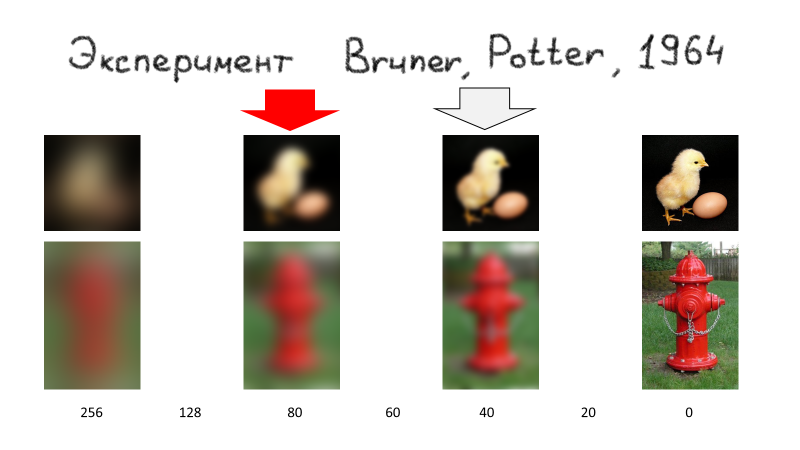
N. N. Taleb interprets the results of this experiment as follows: if our brain is given a lot of information, then it will build many different hypotheses, and more information will be needed to refute most of these hypotheses.
2. The Ingar-Lepper experiment (2000)
Experiments on human beings in the field of psychology are generally amusing.
I studied at the Physical Department and defended my dissertation there. And when he wrote a book, he read many articles on applied and experimental psychology. Once I came across an article with a title in the spirit of “Studies on the attractiveness of female breasts for different cultures” - a good article with illustrations. I send it to my supervisor, and he answers me: “Damn, Max, we were doing the wrong thing all the time!” - we were engaged in waveguides. A bit later he adds: “Not exactly the same, he paid someone else for it” - there was a reference to the grant.
In general, psychology is a very interesting science, especially experimental.
What was the experiment:
- 1 option. The store is a seller near the table with probnichkami 6 different exotic jams.
- Option 2. The same store, the same days of the week, but on the table 24 jam.
Cunning psychologists look at how many people went into the store, how many went to the table, how many they tried, how many they bought.
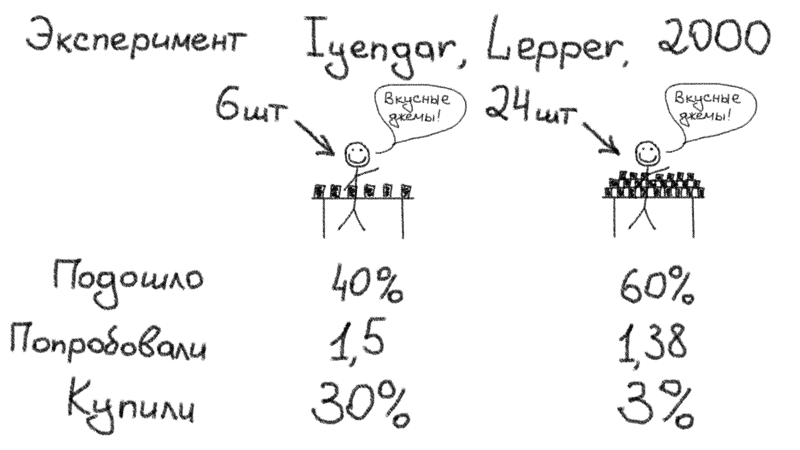
Results:
In the case of 6 jams, fewer visitors approached (40% vs. 60%) - indeed, 24 looks more attractive. I tried to jam about the same number of people. The most interesting thing is how many people bought the product. When there was a choice of 6 jams, virtually every 3rd bought a jar, and in the case of 24 - only 3%. Apparently, this is exactly the area of procrastinotology:
- ABOUT! is all yummy! We must think, I will make a choice later!
Two harmless experiments: people are given more information, and, it would seem, they should make a more informed choice. Perhaps, of course, this is a more balanced choice: “Oh, how much any yummy! No, I'm fat, I will not ... "
Poisoning information
Proceeding from these and a number of other experiments, there is a very interesting pattern, which I call the effect of information poisoning. If you look at the level of our confidence in making this or that decision, depending on the amount of information received, the schedule will have such a sly look.
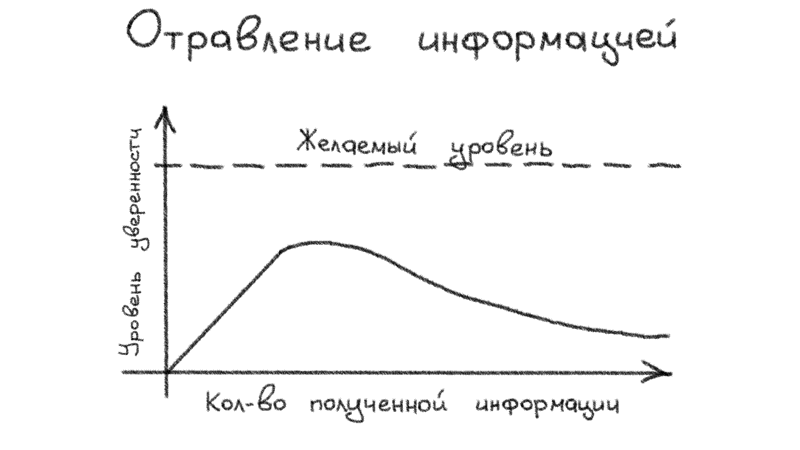
To a certain level, it will be almost linear, or at least monotonically increasing. But we, in order to make a decision, want a very high level of confidence (dashed line). On the one hand, we realized that google, read articles, go to conferences, listen to YouTube, podcasts and everything else - gives us information, and it seems that the desired level is not far. We do it, we do it, we do it - and puff!
To illustrate, give an example of choosing a hotel for a vacation. It seems to be all right, you have already stopped at two options, and then began to read the reviews. And everything, it became not clear what to choose.
Because of this, many people, not understanding this curve, do not consider the redundancy of information to be something bad.
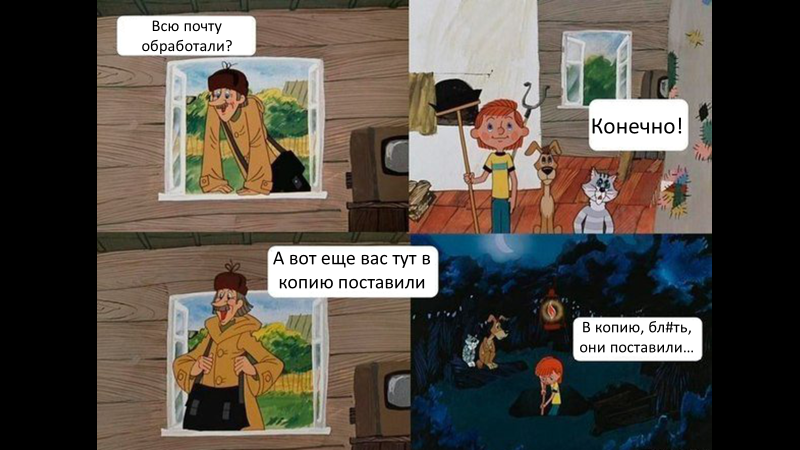
And then they come to my trainings and say:
- What to do, I have 500 letters in the Inboxes, only 1-2 of them are significant and it is impossible to find anything useful.
This was the first point about cognitive obesity. About “thinking laziness”, you may have already heard something, but I will remind you anyway.
Thinking model D. Kahneman
This very intelligent man received a Nobel in economics and very seriously advanced experimental psychological science. He has a model with which he explained a lot of things. According to the model, we have fast (system 1) and slow (system 2) thinking. Every time we get some information, it:
- first falls into system 1, like on the frontend;
- Further, system 1 quickly produces some kind of reaction and either issues it outside or imposes a control on the system 2.
- System 2 can intervene, or decide that it will fit.

I want to illustrate the presence of two systems with one old and simple problem. Just follow how your mind finds the answer to this question.
Given: a baseball with a bat cost 1 dollar 10 cents, a baseball bat is more expensive than a ball for 1 dollar. How much is the ball?
What happens in our mind when it comes to the question of how much does a ball cost?
Everyone knows the expression that a correctly asked question contains half the answer. Someone calls it ancient Eastern wisdom, and someone calls cognitive distortion. Our mind is first of all to find the answer, looking for it in the question itself. Therefore, often the first reflex response of 10 cents. And only then - no, no, I have to think.
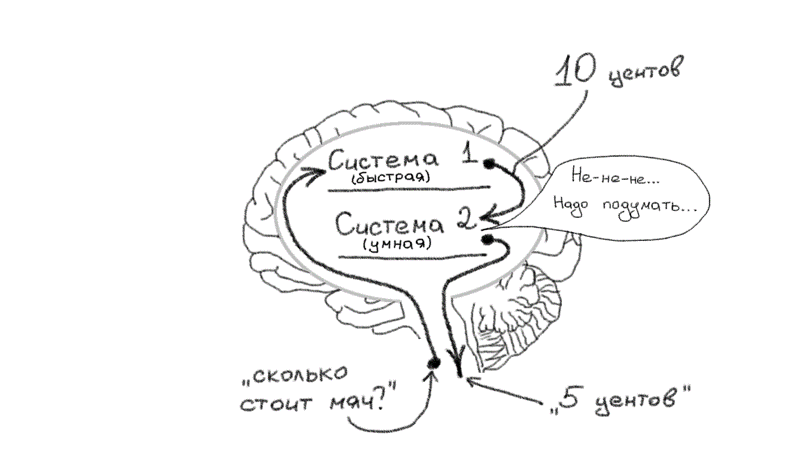
What happens next? There is a certain threshold to the beginning of thinking, in order to start thinking, we need, like a wheel through a curb, to roll through it.
This is a key point, because in most situations where we need to think, there is something that prevents us from thinking. You need to make a little effort on yourself. And if we managed to roll the wheel over the curb (or, if you are from St. Petersburg, through the curb), then the answer is 5 cents quickly.
Let's move our thinking ...
To think laziness! What is the most unpleasant thing than to think, we also have a little.
If we return to the Kaneman model with systems 1 and 2, then for system 2 to work, it needs a certain kind of resource. I call him thinking fuel.
- Thoughtfully eating - I can think.
- There is no fuel mind: - How much does a ball cost? - 10 cents! Thoughts will not arise to doubt.
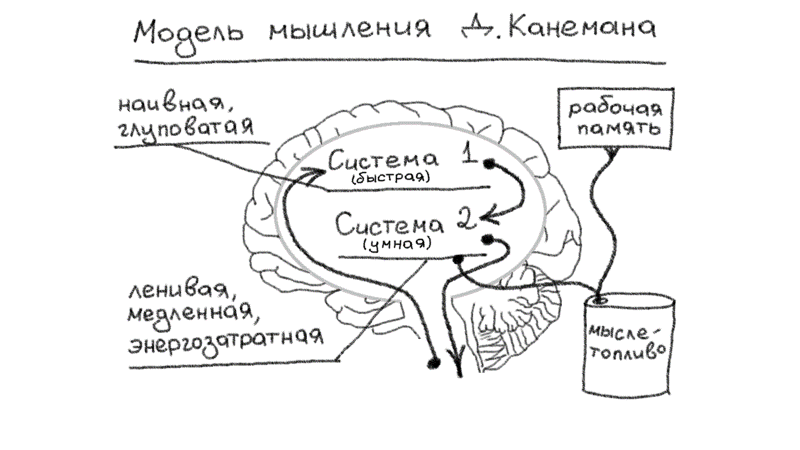
Moreover, our brain has a very stupid architecture, and our working memory is powered from the same tank with the mindset as system 2 (in order to experience this imperfection on yourself, you can watch the experiment ). When we work, and it’s spinning in our head, that we still have to buy milk and send an e-mail, it all climbs into the tank with the fuel, and it is not enough for everyone. Literally 2-3 puzzles remembered, but we can no longer think of anything. Such an unpleasant thing.
The principle of saving fuel
In the question of what to do with it, I rely on the basic principle, which is in the title of this article - the principle of saving the mind of fuel.
Remember, as Matroskin said: “We have money, we don't have enough minds!”
Approximately the same thing happens to us with tasks, tasks, personal life and everything else. Many people complain that they don’t have enough time, but few say that they don’t have enough brains. Although, as a rule, not enough brains. Maybe not the brain, but the thought of the fuel - of what we think.
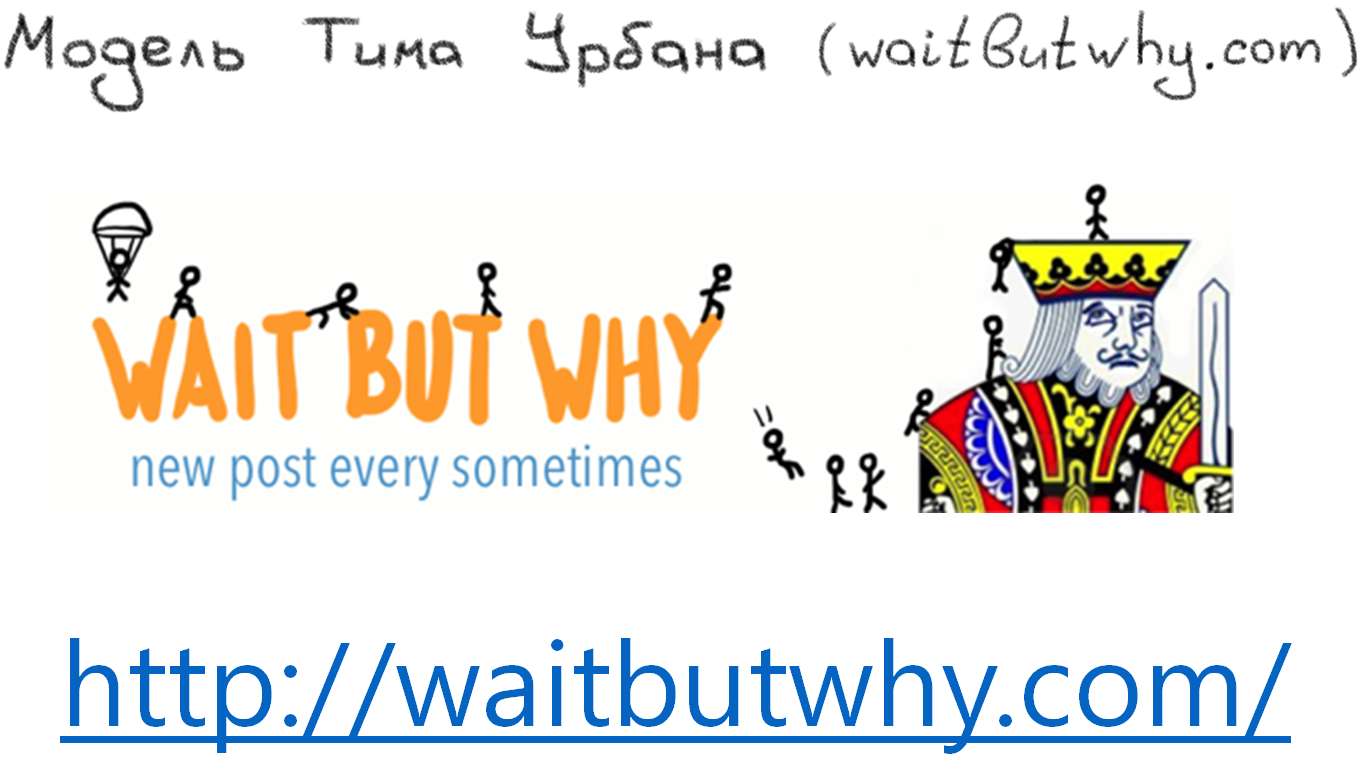
To give some specific recommendations, I would like to refer to the model of Tim Urban . Tim Urban several years ago wrote a series of articles on his blog about how the brain of the procrastinator works. The articles had a great success, he was invited to TED, where he explained how the prokastinator's brain works, based on the article.
But the masterpiece was later in a blog where Tim described how he, being a chronic prokastinator, was preparing to speak on TED on the topic of prokastination. This is generally a smart article, full of pain, tears and everything else.
According to the model of Tim Urban, our head looks like this: in our head there is a control panel, next to the console is a rational type and a monkey of momentary pleasure.
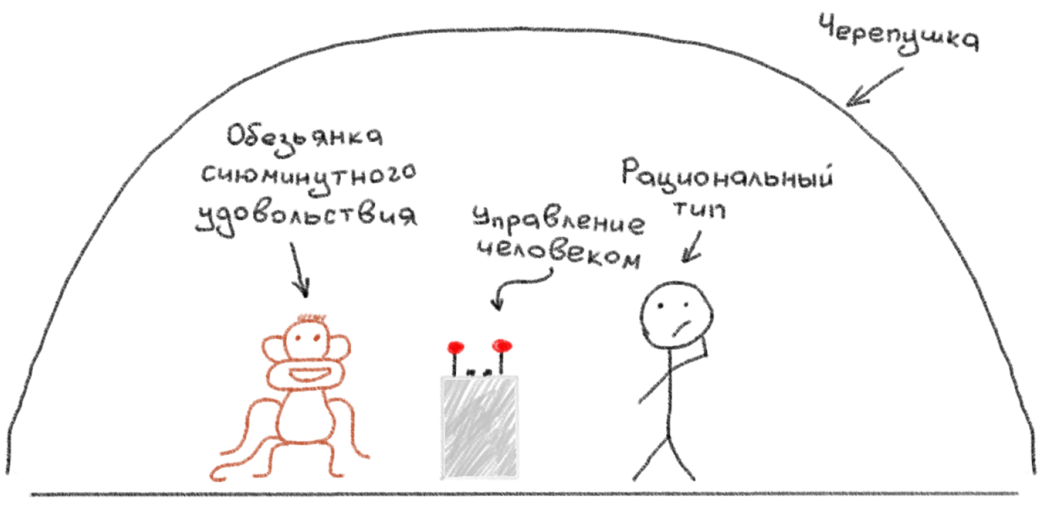
Most of the time at the helm is just a monkey. She likes to watch cats on YouTube, hang out on Facebook, and much more. The rational type tries to influence it in its own words like: “Come on! To have time to complete the task on time, you must start working now! ”
But the monkey does not have an understanding of time - not yesterday and tomorrow, it has a sincere Buddhist "here and now." She is not able to broadcast the lessons of the past for the future.
But Tim says that the procrastinator still has a guardian angel. This is a panic monster - the character who arrives shortly before the deadline and is afraid of the monkey. When it appears, the monkey temporarily retreats.
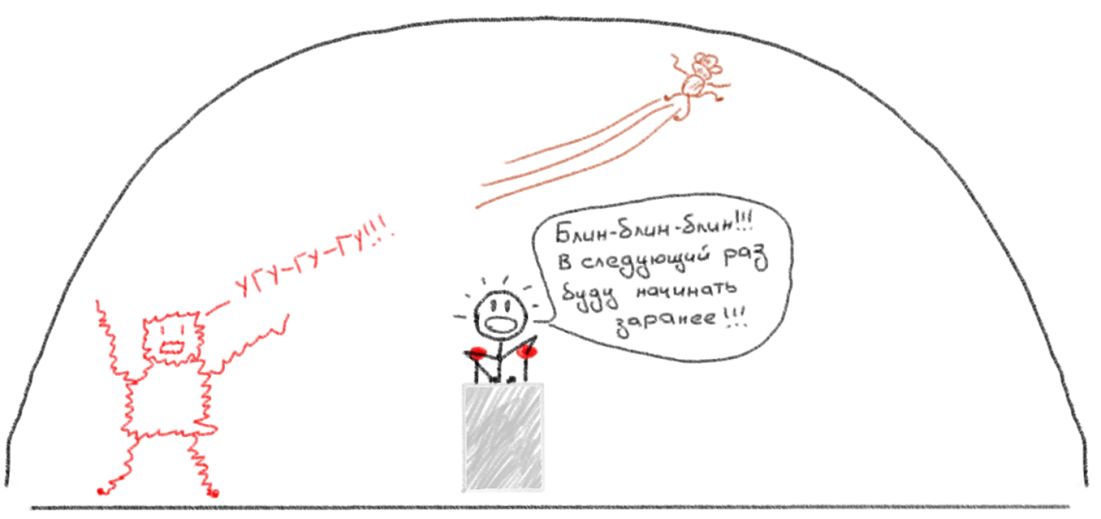
You remember the depth of concentration under the action of the panic of the last minute - this moment is exactly from there. For this reason, on Friday night, you very clearly and quickly do what you had to do last Wednesday, without any problems.
Then, having somehow managed, you begin to swear to yourself that this will never happen again, and so on. This is the time of the peak of perjury. Remember, "I will learn from the first day of the semester?" .. But the session was over, and ... The oath was given to myself, but I could not hold them back. What a bad luck!
What to do with it?
Based on this model, I will give 3 simple tips, and then a small layering on top.
1. To minimize the distraction of the monkey
For her, who is the last, and that important, she does not care about priorities. And most of the time we live in monkey mode.
2. Do only what is written
Many will say - no, this is impossible! Then I will explain why and at the expense of what it is possible.
3. Cook the monkey clear instructions
Many people think that our strategy is to drive out the monkey. But this is not so, because the rational type is very weak and not enduring. Therefore, they are all needed, just need to learn to communicate with them. In many ways, procrastinology is the art of communicating with its inner monkey.
How to minimize the distraction of a monkey
This picture is the most universal tip. Which is fair in general for any email client.

The advice is very simple. There is a tab "File - Options - Mail", and checkboxes in it that are responsible for pop-up notifications when a new letter is received. You have no idea what kind of sabotage it was on the part of Microsoft to make them turned on by default. I think the losses in the economy from these pop-up notifications are comparable to a small natural disaster.
On the one hand, I have already said that we are learning to work with our monkey. To learn well to work with your monkey, you need to live in love and harmony with her.
The monkey Tao cycle looks like this:
- Get the information.
- We comprehend the information and prepare clear instructions to the monkey.
- She practices our instructions.
- In the process of completing the task, we transfer something to the outside world.
Total: received, comprehended, done, transmitted.
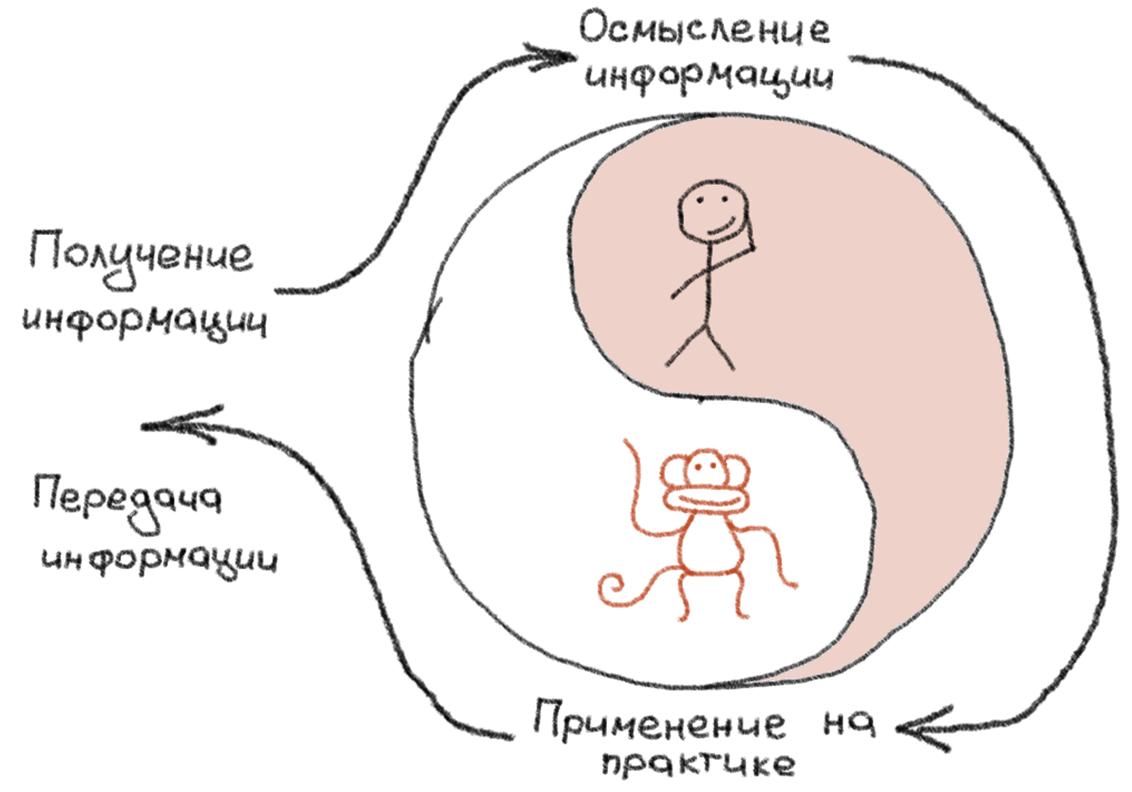
The monkey strongly plugged with notifications ceases to involve the rational component in the processing of the entire input, and a short circuit occurs on the monkey: it has come to her, she replied.
In corporate correspondence, one can often observe chat conversations — these are monkey dialogues. Before comprehension of information and its thoughtful processing, most likely it does not reach. It is useless to write in order to stop wasting time, they have so much fun.
Do only what is written
Many people refer to the daily recording of tasks, like writing a letter to Santa Claus — he wrote, and then you ask — what to do when tasks are not done, but everyone is transferred? It would be nice to make them from there, and then they will be made!
Very often, when I say: “Try to live at least for a while, doing tasks only from your list,” they answer me: “Oh, all right, I have many urgent and sudden tasks. What am I not going to do? ”
No, of course, it is permissible to record and immediately start doing. This is a very simple practice. For laughter, try to live in this mode at least a little bit, at least a couple of hours a day, when you do only what is recorded. Now I will explain why this is useful.
We do not see things as they are.
Do you have such situations:
You have planned your task list in the morning. They came to work, then something incomprehensible happens. In the evening it turns out that none of this has been done.
This moment is the foundation of the Buddhist culture.
We do not see things as they are: I do not do urgent tasks. I do the tasks that I perceive urgent.
We receive information about the outside world, we look at it with our senses. Then it all goes through the brain, a lot of conceptual husks are layered, something is distorted, what is there is removed, and what is not added is added. After that, the brain must make decisions.
In order not to be clever, I will show a rather well-known illusion of Muller-Layer.
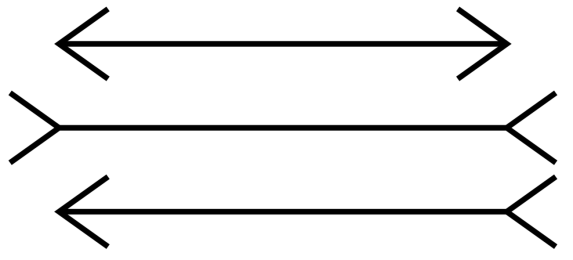
If you look quickly, it seems that the middle line is longer. But these are 3 identical lines.
Our eye reads the shape and color. Everything else is reading the brain. He does not always let us understand that there is a possibility of ambiguous interpretation in the original objects. The brain completes something of its own and gives it out, as the only right answer to consciousness.
If everything is so complicated at the level of perception of visual objects, then what can we say about the audio glitches! If anyone is interested, look at the Winnie the Pooh's Cubic YouTube.
In more complex concepts, such as importance, urgency, the need for continuous distortion. We do not see the world, we do not hear the world, but we understand the urgency!
About arriving tasks
The perception of urgency, importance, and the general sensations of everything in D. Kahneman is called the illusion of focus. He wrote that in life nothing is as important as it seems to us at the moment when we think about it.
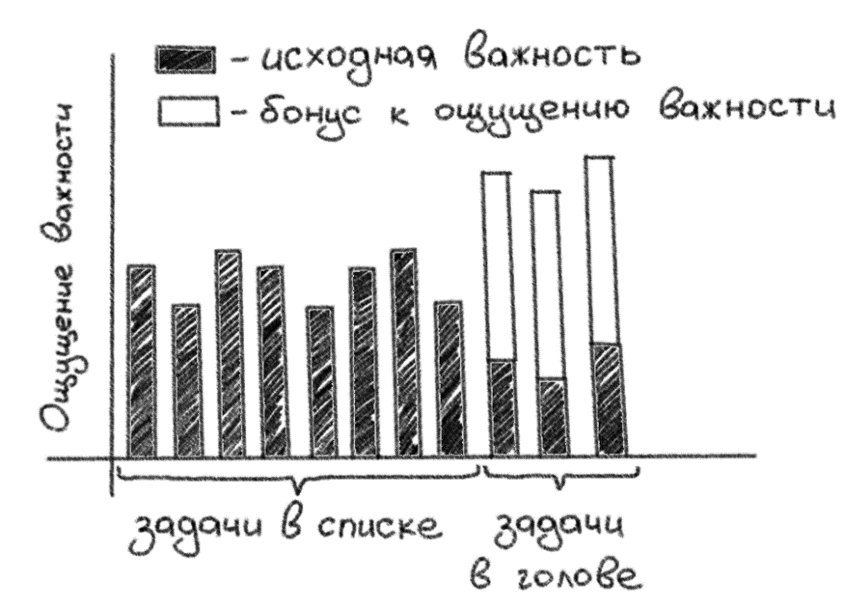
Any thing that now sits in our head seems much more important than it is. If I am completely organized, I recorded many tasks on the list in the morning, and I do everything correctly, my brain let them go.
The push notification that suddenly flashed into my brain with a new task is still fresh in my memory. Only for this, it receives an increase in the sense of importance and, it would seem, not the most urgent task may seem to us more urgent. We do not know what it really is. We just feel.
If we try to take for practice only some time to live, doing the tasks that are recorded, we get the following:
- A task arrives to you. You think: “What is it important! We must do it right there! Dorofeev said that it is possible to write it down and immediately do it. ”
- You record, with your eye you cling to already written tasks. They also receive their bonus to the sense of importance, because they penetrate into your brain, and the comparison becomes more honest.
- It may turn out to be: “Yes, yes, yes, yes, this task is really important, but nevertheless, I planned to do this earlier” - and the situation may be a little better.
Clear monkey instructions
It is very important to be able to choose the right words in the task list because it almost makes the most profit. After all, in order to neutralize the bonus to the sense of importance, it is necessary that this task immediately hit the monkey's brain as soon as it sees the formulation.
I have in the book a quote from a user named Lomelind from my forum. I have not yet seen a better definition of the correct formulation of tasks.

Most of the time we live like a Negro girl. It is possible to believe in it or not, but those who believe in it and adapted to it have an advantage.
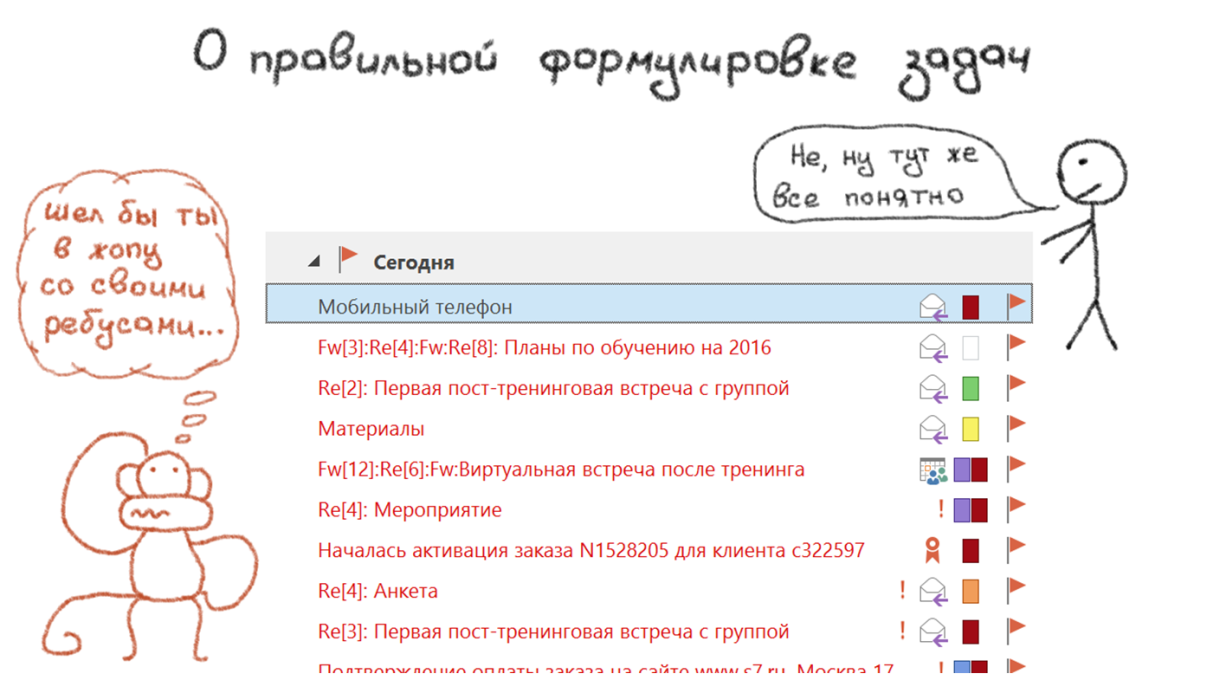
Many people call the task list a nonsense like this, when the boxes on the heap of letters are just thoughtlessly checked, and everything will be red and expired.
But the task list is a tool above all for a monkey. It should be clear to her, otherwise it does not matter how many exclamation marks you put and how many different colored categories you hang. The task will be postponed, because the monkey is among the urgent and important chooses clear. It does not matter, priority or not. She whispers softly: let's first deal with the little things, and then do the rest. And just postpones it for later.
Do you recognize this whisper? Every time when confronted with a challenge that requires thought, someone inside whispers: "Let's first deal with the little things." You deal with trifles, you end up thinking, and then you don’t want to think. You look at it all, drooling at the keyboard and think - tomorrow! And tomorrow everything repeats, and so half a year. Easily!
Good task list
A lot depends on how your monkey works. If she perceives your list - she looks at the letters and she immediately wants to do something, this is the correct wording.
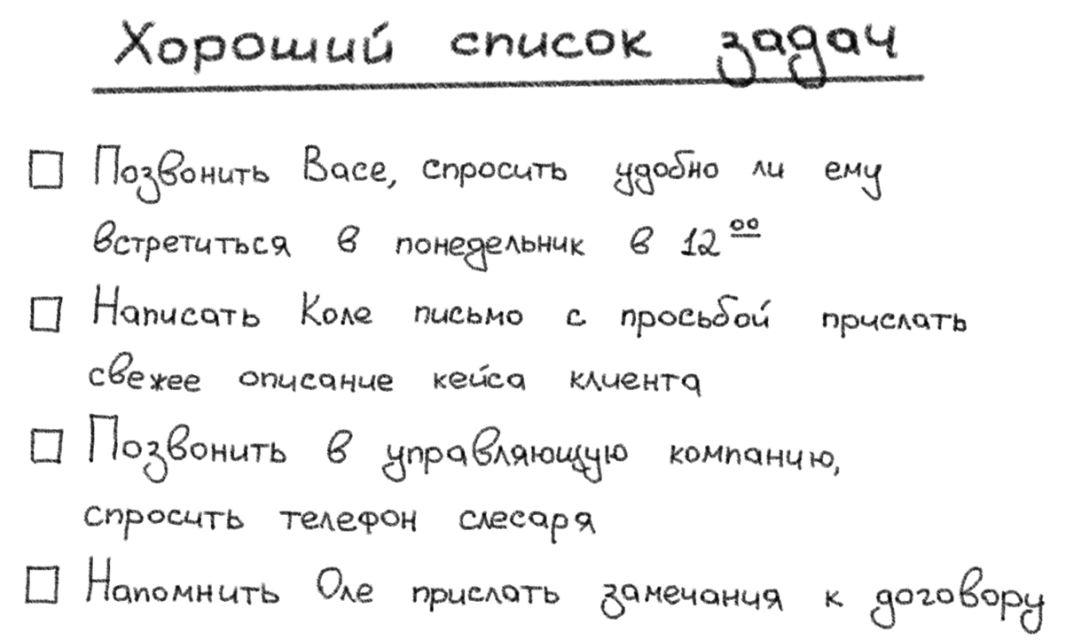
The correct formulation causes what is called the release of shilovzhopina in the blood (such a hormone that encourages us to take and do something).
“Call Vasya and ask ...” - the same task can be written “Make an appointment” or even worse without a verb: “Meeting”. When we write not “Agree with Vasya about a meeting,” but “Call Vasya and ask if he is comfortable to meet soon,” then his hands will reach for the smartphone.
Many may think that this will take so much time. We save time, but we all have enough brains. There is nothing more important than the correct, accurate formulation of tasks for the monkey. Then she becomes your best friend and begins to do many things.
These were 3 simple rules. I don’t say anything more specifically because I’m poisoning you with information. But to finish it would be inhuman, because (remember what I started with):
"... the same actions performed by the same people or companies seem to lead to different, almost random results & raquo
How well you specifically, I do not know. And you do not know until you try.
Daily check list
Sometimes you hold trainings, you look - everyone seems to be listening to you, everyone seems to be interesting and good, but no one does anything. I tried to work with it, increasing and increasing the level of conversion in normal DJs, reached a certain level.
Now I have a little tool. I inherited it at the time from Seva Ustinov. In his blog, I came across an excellent article about the daily check list, and decided to do the same.
To understand what is right for you and what is not, you can try to watch yourself. The check list is very simple: it has columns like in the journal of progress. Every day we in each of them put marks on the lines.
There are 3 categories in the checklist:
1. Vaccines
Their meaning is that you took it once and then the result is with you forever. Examples of vaccines:
- disable incoming mail notifications;
- configure everything read;
- install the magic f.lux program.
You are taking a "vaccine", and at this point tick.
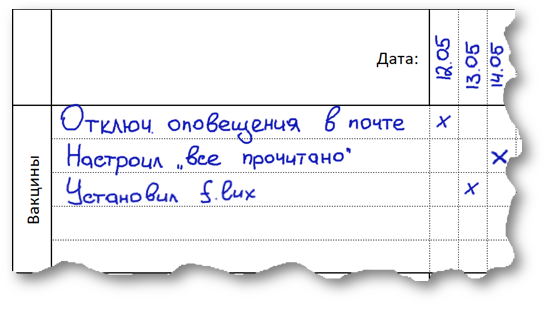
2. Indicators
You do not directly affect the indicators, they affect indirectly, and you can watch them. Indicators can be any, for example:
- mood (subjective on a 5-point scale);
- hours of sleep;
- satisfaction with the results of the day (±);
- battery parameters and stress levels by Welltory.
Welltory is a very good Petersburg startup. Using a smartphone and a camera (if there is a heart rate monitor, even better), they can measure the integral indicator that the developers call a “battery” —that is how long you have silovjopin, and the level of stress — how disturbed you are through heart rate variability.
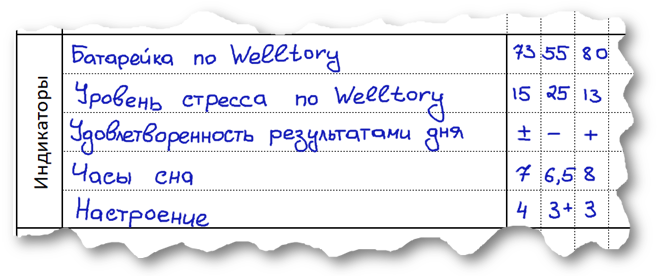
3. Practice.
Unlike vaccines, to get results from the practice, they need to be done every day.Practices may be different, here are just three for example. Very good practice that will help someone, someone does not - “Go to bed without screens” Little foolish practice for those who fall asleep with the screen in their hands until their hands get numb. You can try to sleep without it, and see whether it will affect something or not.
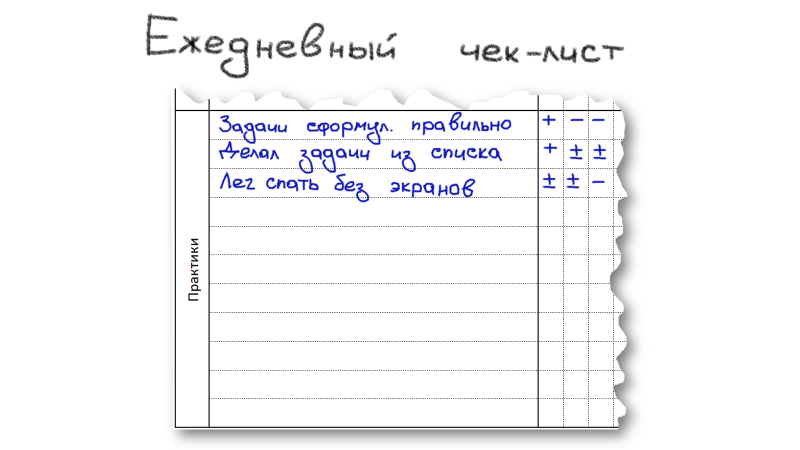
On my forum there is a full menu of all vaccines, indicators and practices at the moment. Try it for yourself - you will not try it - you will not know!
In those moments when you will be faced with complex, unsolvable tasks, and you will need a weighty reason to not do them, you can procast: go to my YouTube channel, read the blog.
It will be a great prokastinaygamek!
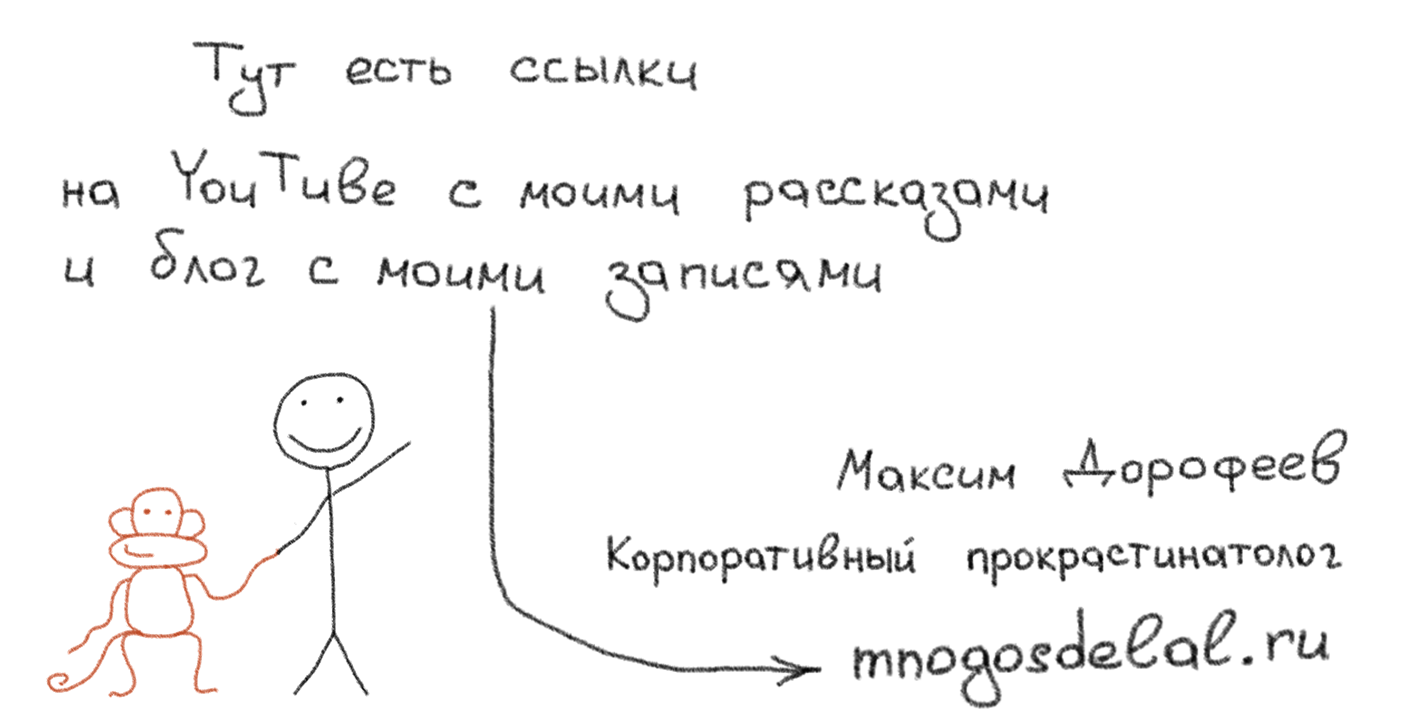
Even better, if you, inspired by what you read, think carefully about what you know best about others and what interesting problems you solve, then immediately send an application to the May festival of RIT ++ conferences. At worst, write in the tasks, just be sure to correctly formulate how Max taught.
Source: https://habr.com/ru/post/348714/
All Articles